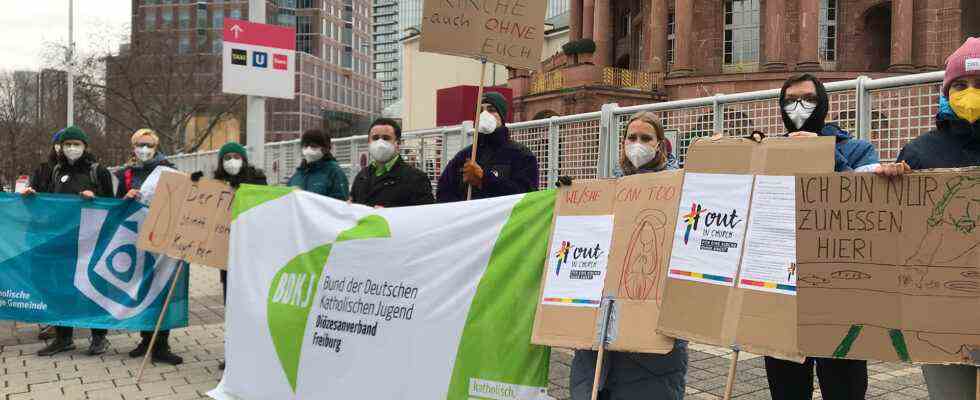Status: 05.02.2022 09:05 a.m
What Keeps Young Catholics in the Church? The gap between church youth and officials is deep, many doubt the ability to reform – and sometimes despair.
Daniela Ordowski sounds disappointed – once again and still: “I can’t just leave the criticism of the church in front of the church door and enjoy the service,” says the 28-year-old. It has now been two weeks since an expert opinion on cases of sexual abuse in the Catholic Church was published. Once again, it showed that leaders of the Catholic Church are still not adequately dealing with allegations and incidents.
Because according to many experts, the report even convicted the emeritus Pope Benedict XVI. the lie “The fact that even he lied and didn’t want to admit it until the end that it was proven to him: Of course it’s difficult to go to church and just pretend that all of a sudden it has no place here.”
deep chasm
As the federal chairman of the Catholic rural youth movement (KLJB), Ordowski represents 70,000 members, making it one of the largest youth organizations in Germany. It is an association that bears its closeness to the Catholic Church in its name. But the gap between the youth in the Catholic Church and their officials and full-time leaders, the so-called official church, is large.
For Ordowski, this gap became particularly clear last year when the Vatican banned the introduction of blessing ceremonies for homosexual couples in Germany, as demanded in Germany: This was shown again to many young people: “These are values that I hold very dear in my life, but my church sees them very differently.”
Third Synodal Assembly: Reform Process in the Catholic Church
Sebastian Kisters, HR, daily topics 10:15 p.m., February 3, 2022
“I no longer defend this church”
As a result, she received many emails from young people. They asked if they could still remain part of the Catholic Rural Youth Movement even if they left the church. “Of course it’s really bad when young people have to justify themselves for this church again and again and maybe there comes a point at which they say: ‘I just don’t protect this church anymore.'”
Does the Catholic Church scare off its young believers? “First and foremost, this is not a question of canon law,” explains Mainz canon law expert Matthias Pulte. “But it has canonical implications.” Between the ages of 14 and 17, young people in preparation for Confirmation deal with their personal faith in the concrete form of the social structure of the church. “They should affirm both their individual relationship with God and their being Catholic in the Church with Confirmation.” But if the ordained ministers in the church were less and less perceived as trustworthy shepherds and credible evangelizers, then young people would align themselves less and less with these authorities.
With this burden, Ordowski is now taking part in the third plenary assembly of the Synodal Path in Frankfurt am Main. Ordowski accompanies this reform process as one of 15 synod members who are younger than 30 years old. Their group size: small – compared to 69 bishops and 27 councils of priests.
synodal path
The third synodal assembly will take place in Frankfurt from February 3rd to 5th. The term “synodal path” refers to the Greek word synod. It literally means “companion along the way”; in ecclesiastical usage, synod means an assembly of bishops or of clergy and laity. In their reform dialogue on the synodal path, the German Catholic bishops and the Central Committee of German Catholics (ZdK) want to discuss the future of church life in Germany. The starting point is a long-standing church crisis that the abuse scandal has exacerbated.
Nevertheless, she expects decisions, for example on the basic order of church service. Among other things, it prescribes to the lay church workers how they should live their sexuality. “Sexuality is a sin; homosexuals must live in chastity, church offices are closed to them; homosexuality is an illness, conversion therapies by the church are actually still allowed,” Ordowski lists. These are things that are now in the texts that need to be changed. “And I think those are the cornerstones that are important for us as a youth right now.”
But is the Catholic Church so capable of reform? Canonist Pulte is only sure if their office holders are willing to implement the reform backlog: Those who really seek advice within the framework of what is already possible and implement the results accordingly are capable of reform.
Reforms are also overdue in Rome, and Pope Francis has emphasized this several times. However, there has been a lack of concrete implementation for almost nine years, says Pulte, citing the reform of the Roman Curia as an example. “As long as the church remains reactive and does not respond proactively to the concerns of the time, which are already being raised by young people today, the entire church as an institution will continue to lose authority and credibility.”
red lines
The fact that Bishop Karl-Heinz Wiesemann of Speyer said in an interview that he could imagine blessing homosexual couples, or that Cardinal Marx from Munich is considering allowing priests to marry – neither gives Ordowski any new hope: “I see in these Words have not been bright spots for a long time. I would like the bishops to finally show that they stand behind their words and are going to Rome with this vote.”
In principle, it is important to young people in the Catholic Church that the synodal path succeeds. But of course there are red lines, such as understanding homosexuality as a disease. “Then this synodal path cannot succeed. Then it is more important that this synodal path crashes into a wall.”

